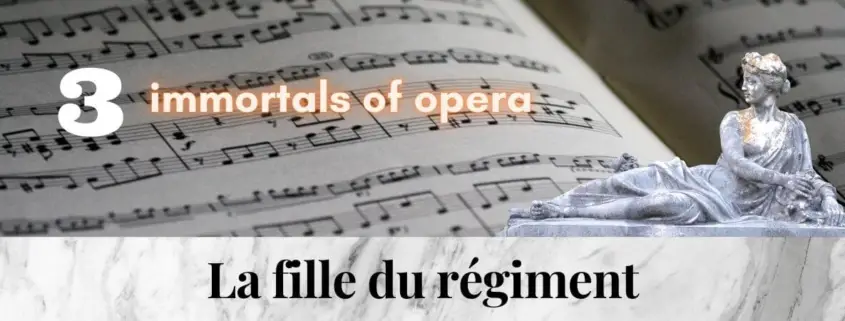3 immortal pieces from Donizetti’s LA FILLE DU REGIMENT – the best interpretations in YouTube
“La fille du régiment” is a firework of voices and calls for two great interpreters of the main roles. The female lead of Marie combines the great voice with that of an exceptional theatrical personality and the male lead the tenor power act of the 9 high C’s of “Pour mon ame”.
“Pour mon ame” Tonio’s tenor aria with high C’s
“Pour mon ame” is the most famous piece of the opera “La fille du régiment” and one of the famous tenor arias ever. It deserves this mainly to the fact that it requires from the singer an incredible 9 high C’s in only 2 minutes. The challenge of the aria is that the high C’s must be sung with a robust chest tone and clear intonation (it should be noted that at the time of composition, the high C may have been sung only with the falsetto. Tenor Duprez first sang it with the chest tone, the so-called “do in petto,” in William Tell in 1837, establishing the subject of the Heldentenor).
Pavarotti’s MET performances of this 1972 work have since become legend. He took the audience by storm with this aria and, with the subsequent tour of the United States, became definitively the tenorissimo on the American continent and the globe. He was given the nickname “King of the High C’s.”
“La fille du régiment” is one of the greatest recordings Pavarotti made. It was only his second complete recording of his still young recording career. John Steane (“The grand tradition”), the influential critic speaks of one of the finest tenor performances on record anywhere, sung with the finesse the mature artist and the blooming voice of the young man in the form of his life. Music journalist Edward Greenfield was present at the recording sessions and reported that this aria was recorded several times before it was “in the can” and Pavarotti repeated this straining act over and over again without grumbling.
Pour mon ame – Pavarotti
The great scene of the singing lesson
This scene has a well-known model, the singing lesson of Rosina from Barbiere di Siviglia. Donizetti knew this work, of course, and fashioned an independent piece. As in the Barbiere, Marie must sing an old-fashioned aria with languorous trills and roulades (Le jour naissait dans le bocage), which the Marquise accompanies on the piano with almost grotesque and simple chords. Sulpice sabotages it with interjections from Rataplan. Marie begins the song willingly, but soon, to the Marquise’s horror, she lapses back into the military with a cascade of scales and arpeggios and sings the regimental song. The Marquise is dismayed at the relapse after 1 year of training.
The second version is again a live recording where Nathalie Dessay simply carries the listener away with the comedic facility.
Le jour naissait dans le bocage – Dessay / Corbelli
The reunion with Tonio and the tercet
This tercet is a typical product of the Opéra comique. One almost has the feeling of already anticipating Offenbach, who wrote his first operettas 15 years later. The repetitive elements and the exuberant melody imbued with dance-like rhythms is deeply operetta-like. Donizetti’s ability to adapt to local conditions earned him the nickname “musical chameleon.”
Tous les trois réunis – Dessay / Florez / Corbelli







Leave a Reply
Want to join the discussion?Feel free to contribute!